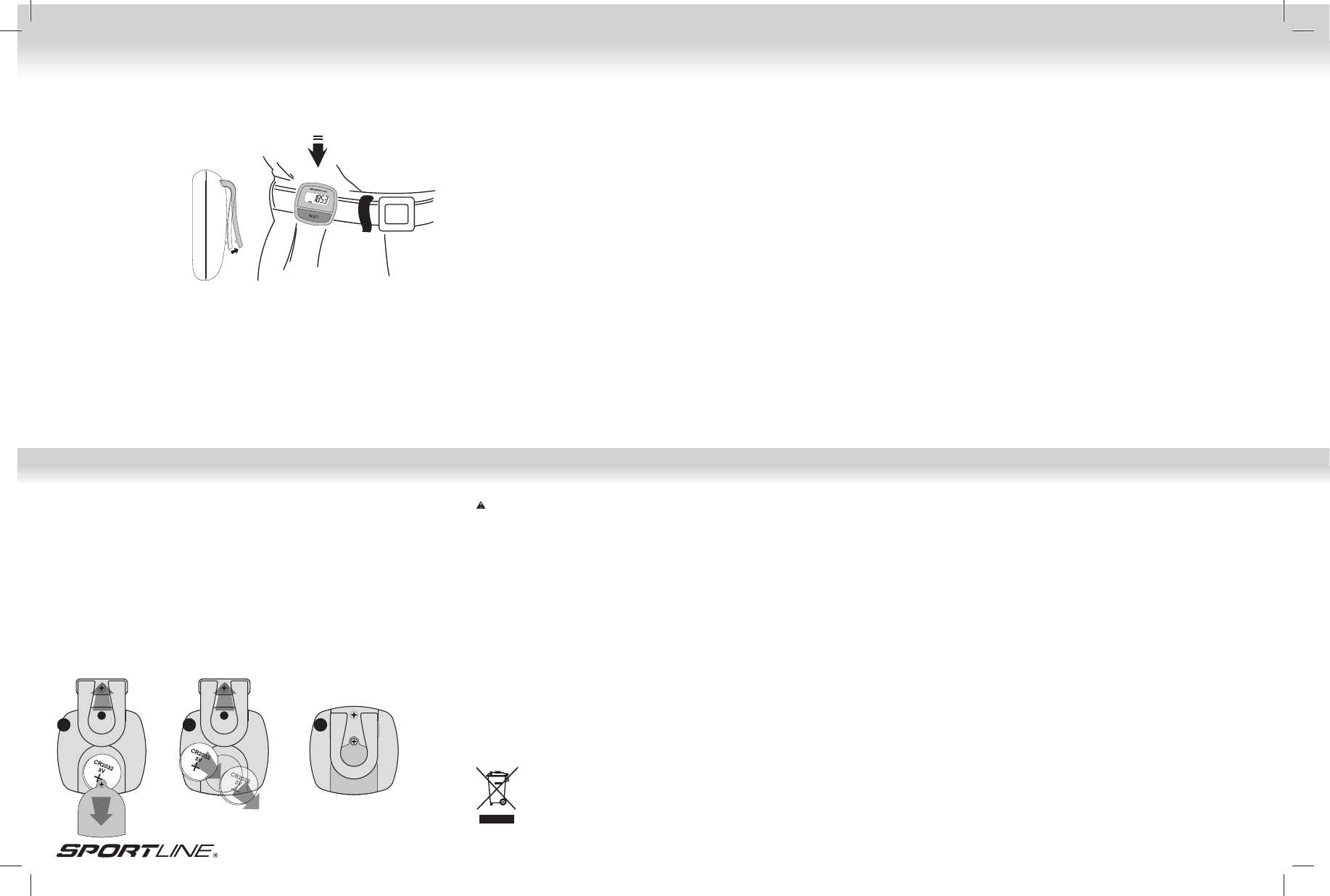
330 PEDOMETER
8- COMPLIANCE
This digital apparatus does not exceed the Class B limits for radio noise emissions
from digital apparatus as set out in the interference-causing equipment
standard entitled “Digital Apparatus”, ICES-003 of the Canadian Department of
Communications.
www.sportline.com
9- REPLACING THE BATTERY
The Sportline 330 Pedometer uses one CR2032 3V lithium battery.
Battery replacement will be required from time to time, and should occur when:
1. The display fades in part or completely
2. The pedometer function will not activate
TO REPLACE THE BATTERY:
1. Unscrew the battery compartment door and the belt clip assembly with a small
Phillips screwdriver.
2. Remove the exhausted battery from the unit, and insert a new battery (be sure to
place the positive (+) side of the battery facing up).
3. Replace the battery compartment door and belt clip assembly. Fasten the screws
with a small Phillips screwdriver.
10- BATTERY SAFETY INFORMATION
CAUTION – BATTERY SAFETY INFORMATION
• Non-rechargeable batteries are not to be recharged
• Rechargeable batteries must be removed before recharging
• Rechargeable batteries should only be recharged under adult supervision
• Do not mix alkaline, standard (carbon-zinc), or rechargeable (nickel-cadmium)
batteries
• Exhausted batteries are to be removed
• Do not mix old and new batteries
• Do not dispose of batteries in fi re; batteries may explode or leak
• Do not dispose of product in fi re; batteries may explode or leak
• If this product will not be used for an extended period of time, remove the
batteries from the product
• The supply terminals are not to be short-circuited
• Batteries are to be inserted with correct polarity
• Clean the battery contacts and also those of the product prior to battery
installation
• As always, dispose of batteries in an eco-friendly manner
The purpose of the crossed-out wheelie bin symbol is to remind us that most electrical products,
and batteries, contain trace elements (including Mercury – Hg, Cadmium – Cd and Lead – Pb) which
could be harmful to our environment and therefore our health. We must all be careful to dispose of
them responsibly in a specifi cally designated way – either using a collection scheme or into the
correctly labeled civic amenity (NOT into general waste) – this will help your local authority to
arrange to recycle or dispose of them in the appropriate manner.
6- HOW TO WEAR THE PEDOMETER
This pedometer will be most accurate when worn close to the body, ideally on your
belt or waist line or inserting the unit into a tight, secure pocket.
7- WARNINGS & CAUTIONS
WARNING: Before starting any exercise program or performing any vigorous
physical activity, we strongly suggest you visit your doctor for a complete physical
and to discuss your plans.
CAUTION: Pedometers are not water resistant.
AVOID exposing the Pedometer to extreme conditions.
AVOID rough uses or severe impacts to the Pedometer.
CLEAN the Pedometer occasionally with a soft, dry cloth.
STORE the Pedometer in a dry place when it is not in use for a long time.
CARE & MAINTENANCE
NEVER get the pedometer wet. This unit is not water resistant.
NEVER attempt to disassemble or service your unit.
DO NOT expose the unit to extreme heat, shocks, magnetic fi elds, electrical noise,
strong vibration or long-term exposure to direct sunlight.
DO NOT drop or step on the pedometer.
TO CLEAN the unit: wipe with a lightly moistened cloth. Apply mild soap to the area if
there are stubborn stains or marks. Do not expose the unit to strong chemicals such
as gasoline, cleaning solvents, acetone, alcohol, or insect repellents, as they may
damage the unit’s seal, case and/or fi nish.
STORE the unit in a dry place when you are not using it.
1 2 3
WV1054IS02SCC.indd 2WV1054IS02SCC.indd 2 9/13/12 5:30 PM9/13/12 5:30 PM






